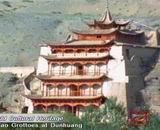 Dunhuang is located in the southwest of Gansu. The ancient Silk Road passed here after Gansu Corridor. Dunhuang was the last stop on the Silk Road before the West Asia, also the last stop for an east-bound journey before the Central Plain. The significance of Dunhuang lies in its grottoes, mural caves refusing to go under yellow sands. These grottoes are museums of ancient arts and the intersection of Western and Oriental civilizations. These caves document cultural exchanges, a witness of the significant Silk Road. Among all, Mogao Grottoes are representative. These caves were cut on a cliff 25 kilometers southeast to Dunhuang, on a mount called Mingsha. Beginning from AD 366, during the ensuing 1000 years, more stone caves were seen, eventually formed a 1680-meter long south-north complex, with 735 caves from different dynasties. Dunhuang is located in the southwest of Gansu. The ancient Silk Road passed here after Gansu Corridor. Dunhuang was the last stop on the Silk Road before the West Asia, also the last stop for an east-bound journey before the Central Plain. The significance of Dunhuang lies in its grottoes, mural caves refusing to go under yellow sands. These grottoes are museums of ancient arts and the intersection of Western and Oriental civilizations. These caves document cultural exchanges, a witness of the significant Silk Road. Among all, Mogao Grottoes are representative. These caves were cut on a cliff 25 kilometers southeast to Dunhuang, on a mount called Mingsha. Beginning from AD 366, during the ensuing 1000 years, more stone caves were seen, eventually formed a 1680-meter long south-north complex, with 735 caves from different dynasties.
The complex has two areas, the south and north. The 492 caves in the south were for a worshipping purpose. They have over 2,000 color statues, 45,000 square-meter frescoes, and five wood eave structures. The 243 caves in the north were for monks to live, for a religious practice and a tomb yard. No color sculptures and frescoes are there. Dunhuang art has architecture, color sculptures and murals in one.
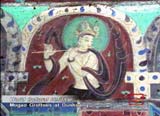 During the Sui and Tang dynasties, Dunhuan art reached its prime. Images presented were no longer alien, but Chinese, female and worldly, in a singing or dancing performance. A merry mood and a high-life style were obvious. Flying deities exhibited a Western and Eastern cultural combination. Dunhuang art embraced different cultures. Because of this it was full of vitality.
During the Sui and Tang dynasties, Dunhuan art reached its prime. Images presented were no longer alien, but Chinese, female and worldly, in a singing or dancing performance. A merry mood and a high-life style were obvious. Flying deities exhibited a Western and Eastern cultural combination. Dunhuang art embraced different cultures. Because of this it was full of vitality.
Technically, Dunhuang art adopted Chinese delineation and Western patch coloring. Human expressions were rendered life-like.
After Sui Dynasty, the fresco art was mature during Tang. Spectacular palaces, grand landscape, all found their way into a Chinese painting. Big subject matter was possible through matured Chinese painting techniques.
Dancing images in Dunhuang frescoes are a brilliant gem for all human beings. This reversed pipa-playing pose stimulated the idea for Silk Road and Flying Deities, a dance drama highly successful in and outside China.
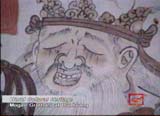 Over 200 caves have music as their theme. Band images of varied sizes are over 500, 4,500 musical pieces in 40 kinds. We are able to recognize some of them, pi pa, kong hou, qiang di and hu jiao. But their ethereal ensemble is no longer available.
Over 200 caves have music as their theme. Band images of varied sizes are over 500, 4,500 musical pieces in 40 kinds. We are able to recognize some of them, pi pa, kong hou, qiang di and hu jiao. But their ethereal ensemble is no longer available.
The fast moving twirling dance is West Asian. Bai Juyi once exclaimed, “Never fatigued from twirling, turn after turn for no end.” It is said that An Lushan and the Royal Concubine Yang were two best dancers in this style. Just imagine the grandeur of a huge performance by several hundred people. It was the hallmark of powerful Tang. The Emperor of Xuanzong was said able to direct such a grand show, and was able to tell even a slight mistake when it occurred. Such a grand scene is only available in those frescoes.
The beginning of the 20th century saw the most shame in Chinese history. In May 1900, the Eight-power Allied Forces, armed with fire weapons, blast open the gate to Beijing. The big-power dream by Qing government was smashed. The Empress Dowager Cix fled to Xi’an for her dear life, bringing along her ministers. The debris on fire was left behind, so were people to suffer. During this nation-wide chaos, at this miserable moment, the door to Dunhuang treasure was accidentally pushed open by a Taoist priest Wang Yuanlu. Wang had served in the army before he was converted into Taoism. Painful at the damage, Wang hit upon an idea to remodel these caves. The next month after the eight powers took Beijing, Wang hired a man surnamed Yang to copy the writings on murals. The torch in Yang’s hand disclosed a world-astounding discovery. At that time, all the eyes were on the Bohai Bay. No one cast a look at those dark and cold caves.
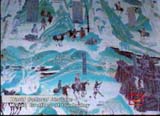 Wang sent to the county magistrate Wang Zonghan a few sutra scrolls he had found. The doubtful Wang delivered them to Ye Changzhi, the education officer in Gansu. At the sight of them, Ye, an epigraphic scholar, proposed an immediate shipping of everything to Lanzhou, the provincial capital. However, that careless local government refused to allocate a fund for transportation. In March 1904, it just instructed Dunhuang county magistrate to count items discovered.
Wang sent to the county magistrate Wang Zonghan a few sutra scrolls he had found. The doubtful Wang delivered them to Ye Changzhi, the education officer in Gansu. At the sight of them, Ye, an epigraphic scholar, proposed an immediate shipping of everything to Lanzhou, the provincial capital. However, that careless local government refused to allocate a fund for transportation. In March 1904, it just instructed Dunhuang county magistrate to count items discovered.
In February 1906, Marc Aurel Stein, a Jewish working for British Government, came to China once again. He had learnt from a Turkish merchant of Priest Wang’s discovery. Stein rushed to Dunhuang. To his appointment, he found Wang was difficult to deal with. Money was not the only thing he needed.
With the help from his interpreter Jiang Xiaowan, Stein convinced Wang of his false identity, a Buddhist follower on a pilgrimage for sutras. When he was finally allowed into the Sutra Cave, he stood there in awe. He described the scene in his book, “Travel in West Asia”, “When I peeped in through a small hole, my eyes popped out in a big surprise. By the dim light from Wang’s candle, piled up scrolls of ancient sutras were as high as 10 feet, about 500 square feet in size. The next seven days and nights saw the frantic Stein rummaging among them. These ancient scrolls and beautiful frescoes, he said, outdid any discovery he had made before. With 3,000 sutra scrolls and 500 paintings packed in 29 huge wood boxes, he left the place. The payment he gave to Wang was 40 pieces of silver, about 200 taels.
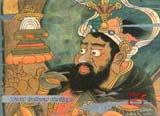 Sixteen months later, when these boxes arrived at British Museum, the whole Europe was astounded. Stein’s discovery was viewed as one of the greatest findings in the 20th century. Other Western states turned their eyes to Dunhuang, to Buddhist caves in a vast desert. Explorers from France, Japan, Russia and the United States rushed here. The lonely Dunhuang had suddenly seen so many foreign visitors.
Sixteen months later, when these boxes arrived at British Museum, the whole Europe was astounded. Stein’s discovery was viewed as one of the greatest findings in the 20th century. Other Western states turned their eyes to Dunhuang, to Buddhist caves in a vast desert. Explorers from France, Japan, Russia and the United States rushed here. The lonely Dunhuang had suddenly seen so many foreign visitors.
In his diary, A French explorer, Paul Pelliot, recorded his experience. “It is a holiday today. I remained in the cave for a dozen hours in run. I was still excited.” Langdon Warner, an American, hurried to Dunhuang in 1924. At those beautiful murals, he was left speechless. With prepared glue tapes he took 26, the best ones, and several color statues, including a 1.2-meter tall kneeling Guanyin statue. Russian explorers were not to be left behind. Early in 1905, they had taken away some from the Priest Wang. In 1914, Sergei Oldenburg came and left with more murals and color statues. Yoshikawa Syoichiro and another Japanese explorer took 300 sutra scrolls, two Tang-dynasty statues and many Turban documents in 1911. Paul Pelliot proudly showed off his possessions in Beijing. Taken aback at what he saw, Luo Zhenyu quickly reported to the Qing government. Looting continued in Dunhuang until 1909, when Qing government instructed all of the sutra scrolls be shipped to Beijing. However, along the way, thefts happened frequently. Out of 40,000d, only 8,697 arrived in Beijing.
Collections from Dunhuang in the British Museum cover many areas in life. They are in Chinese and minorities languages. Sanskrit is among them. These records make a valuable resource for the study of culture and history of ancient ethnic groups. The documents cover almost all aspects in a society, medicine, military, literature, performing art, rhyming multiplication table, models of calligraphy, deeds for lands and human transactions, everything.
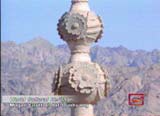 Paintings from Tang are extremely rare today. But many were found in the Sutra Cave in Dunhuang. Among them, the best one is in the British Museum, this Samnatabhadra Bodhisattva on a white elephant. Equally vivid is the Buddhist warrior beside. Their flowing delineation and bright colors exhibit excellent skills.
Paintings from Tang are extremely rare today. But many were found in the Sutra Cave in Dunhuang. Among them, the best one is in the British Museum, this Samnatabhadra Bodhisattva on a white elephant. Equally vivid is the Buddhist warrior beside. Their flowing delineation and bright colors exhibit excellent skills.
Paul Pelliot was well-versed in Chinese studies. He brought 6,000 valuable pieces to Paris in 1908. These precious documents covered archeology, language and culture.
The Fogg Art Museum in Harvard University has parts of murals taken away by Langdon Warner with glue tapes. Due to insufficient tapes, he could only take the best part in a mural. These parts make an undeniable proof of destruction by him.
Due to the Second World War air-raids, Dunhuang pieces brought to Japan left museums to be private collections, thus very hard to be traced.
The loss of Sutra Cave contents gave rise to an international Dunhuang studies. On the other hand, incompleteness has brought much difficulty to a consistent research.
How many pieces from Dunhuan scattering in the world, or locked in a cabinet as a private possession, nobody can tell.
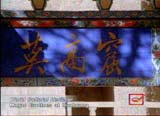 In 1909, the Qing government was at the edge of collapse. Luo Zhenyu, an established epigrapher, as usual, stepped into an art shop in Suzhou Lane. He was taken aback at what he saw. After repeated enquiries, he learnt those rare pieces were from Paul Pelliot, a French. With his friends, they found the French, and learnt their origin, the sandy and windy Mogao Grottoes in Dunhuang. Every day after that, anxtious Luo and his friends went to Paul Pelliot’s house to copy Dunhuang records. Their actions started an arduous journey for Chinese Dunhuang Study. Luo reported the perilous situation in Dunhuang to Qiao Shunan, a Qing minister. The latter gave an instruction to the Shaanxi-Gansu Governor, the Sutra Cave be sealed up. 6,000 taels were allocated for Xinjiang governor He Yansheng to transport all the contents to Beijing.
In 1909, the Qing government was at the edge of collapse. Luo Zhenyu, an established epigrapher, as usual, stepped into an art shop in Suzhou Lane. He was taken aback at what he saw. After repeated enquiries, he learnt those rare pieces were from Paul Pelliot, a French. With his friends, they found the French, and learnt their origin, the sandy and windy Mogao Grottoes in Dunhuang. Every day after that, anxtious Luo and his friends went to Paul Pelliot’s house to copy Dunhuang records. Their actions started an arduous journey for Chinese Dunhuang Study. Luo reported the perilous situation in Dunhuang to Qiao Shunan, a Qing minister. The latter gave an instruction to the Shaanxi-Gansu Governor, the Sutra Cave be sealed up. 6,000 taels were allocated for Xinjiang governor He Yansheng to transport all the contents to Beijing.
Before He and his transportation team arrived, the Priest Wang Yuanlu hid the most precious copies in two huge sutra-tuning barrels. Later, these documents fell into the hands of Aurel Stein and Daika Exploration Team from Japan. Marc Aurel Stein, on his second trip to China, shipped more Dunhuang documents abroad. The Japanese team did the same. The books shipped by He Yansheng suffered a loss from local officials along the way. After the team arrived in Beijing, He directed the team to his home instead of an official storage. He told his son to go through them and keep the best.
He cut the remaining volumes to make up the missing copies. He eventually sold his possessions to Japanese for 80,000 yen. This act was probably the most outrageous in Dunhuang tragedy.
Famous scholars started a salvaging movement. Liu Bannong, a linguistic expert, copied 104 Dunhuang documents in Paris State Museum.
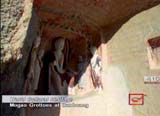 However, the situation worsened in Dunhuang. At continuous damage from wind and desert, and from a severe natural weathering, those caves might collapse at any time. Villagers herded their livestock before Mogao Grottoes. They set up bonfires for cooking.
However, the situation worsened in Dunhuang. At continuous damage from wind and desert, and from a severe natural weathering, those caves might collapse at any time. Villagers herded their livestock before Mogao Grottoes. They set up bonfires for cooking.
In 1920, the most unbelievable thing happened. Some soldiers fleeing Russia after 1917 Revolution crossed borders. 550 were detained by local Qing government in deteriorating Mogao Grottoes.
Those Russian soldiers registered their despair on murals. Dirty words in Slavic language, their troops numbers, and smudge from firing were seen. While the grottoes continued to suffer, Chinese scholars started a salvaging movement in European libraries and museums.
Wang Zhongmin, Xiang Da and Jiang Liangfu, young scholars sent by Qing government, were among volunteers. In Paris National Library, Wang Zhongmin copied down documents stolen by Paul Pelliot. He was assisted by Jiang Liangfu. The latter spent all his time on this, giving up the opportunity for an archeological degree.
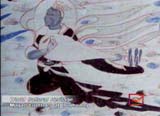 In 1941, while Japanese armies were trampling upon China, visitors to Dunhuang had a big surprise at the sight of the world-famous Zhang Daqian. In a shabby robe, Zhang was copying murals attentively. He had planned to stay for three months, but exclaimed that half a year was not enough. Seven months later, Zhang went to Lanzhou. He had some of his copied works delivered to Chengdu for “West Journey Oils Exhibition”. Fu Xinshe described Zhang as “Number one in the universe”. Xu Beihong marveled by saying, “No forerunner before and successor after”. Did such a great master have to learn from other resource? Someone claimed Zhang had been reduced to a painter, no longer a great artist. But Zhang was firm. Zhang had led a high life anywhere he had been. But next year, he brought his family and stayed in the shabby Mogao Grottoes. When they arrived, it was mid-night. In spite of travel fatigue, Zhang, armed with a torch and candles, visited the Sutra Cave before taking a rest. Just like ancient painters in history, Zhang on a high stand held a candle in one hand and brush in the other. Each brushing cost him much sweat. He worked hard and numbered every mural. He copied 276 in all from five-layered caves. The three years he spent there moved many people. Soon, a research group from the education ministry came.
In 1941, while Japanese armies were trampling upon China, visitors to Dunhuang had a big surprise at the sight of the world-famous Zhang Daqian. In a shabby robe, Zhang was copying murals attentively. He had planned to stay for three months, but exclaimed that half a year was not enough. Seven months later, Zhang went to Lanzhou. He had some of his copied works delivered to Chengdu for “West Journey Oils Exhibition”. Fu Xinshe described Zhang as “Number one in the universe”. Xu Beihong marveled by saying, “No forerunner before and successor after”. Did such a great master have to learn from other resource? Someone claimed Zhang had been reduced to a painter, no longer a great artist. But Zhang was firm. Zhang had led a high life anywhere he had been. But next year, he brought his family and stayed in the shabby Mogao Grottoes. When they arrived, it was mid-night. In spite of travel fatigue, Zhang, armed with a torch and candles, visited the Sutra Cave before taking a rest. Just like ancient painters in history, Zhang on a high stand held a candle in one hand and brush in the other. Each brushing cost him much sweat. He worked hard and numbered every mural. He copied 276 in all from five-layered caves. The three years he spent there moved many people. Soon, a research group from the education ministry came.
The group arrived at the Yulin Cave. Yu Youren, Chief of the Supervising Commission of the Republic Government, came too. Zhang suggested an institute be set up for protection.
Yu proposed to the Republic Government for establishing a Dunhuang art institute. Chang Shuhong, an overseas student from Paris, was nominated for this job. When Chang arrived, Zhang Daqian joked with him by saying, “I’m leaving, but you’ll stay indefinitely for a research, just like a life-long imprisonment.” Zhang was not exaggerating. For besides a hard life, loneliness was unendurable. Chang’s wife left him later, but Chang stayed for his goal.
His basket for picking mushrooms and old gasoline lamp told his 50-year hardship. Hard as it was, Chang never stopped his painting and study.
Following him, Duan Wenjie, Fan Jinshi and other scholars came. With joint efforts they pushed forward the career Chang had initiated. Protection and study of Dunhuang treasure was developing. Their achievements had drawn much attention from academic worlds, domestic and international. These scholars were leading in this field.
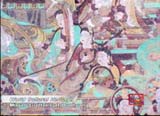 Sand control is a key issue to Mogao Grottoes. With the Western Development, ecology is emphasized. Sand damage will leave Dunhuang for sure.
Sand control is a key issue to Mogao Grottoes. With the Western Development, ecology is emphasized. Sand damage will leave Dunhuang for sure.
Protective medicine injected into murals prevents a natural deterioration. Copying down everything, using replicas for exhibitions, is probably the most effective measure. The last hundred-year history in Dunhuang has seen many youths and lives sacrificed. Tragic history has stimulated a harder academic study. Chinese people won’t be left behind. This is the wish of whole nation.
|